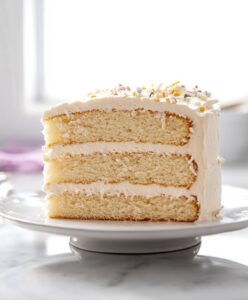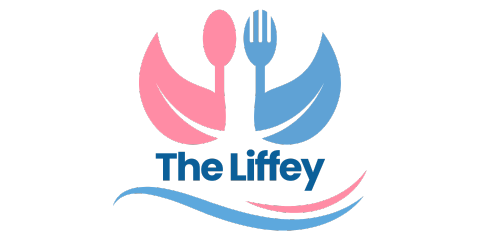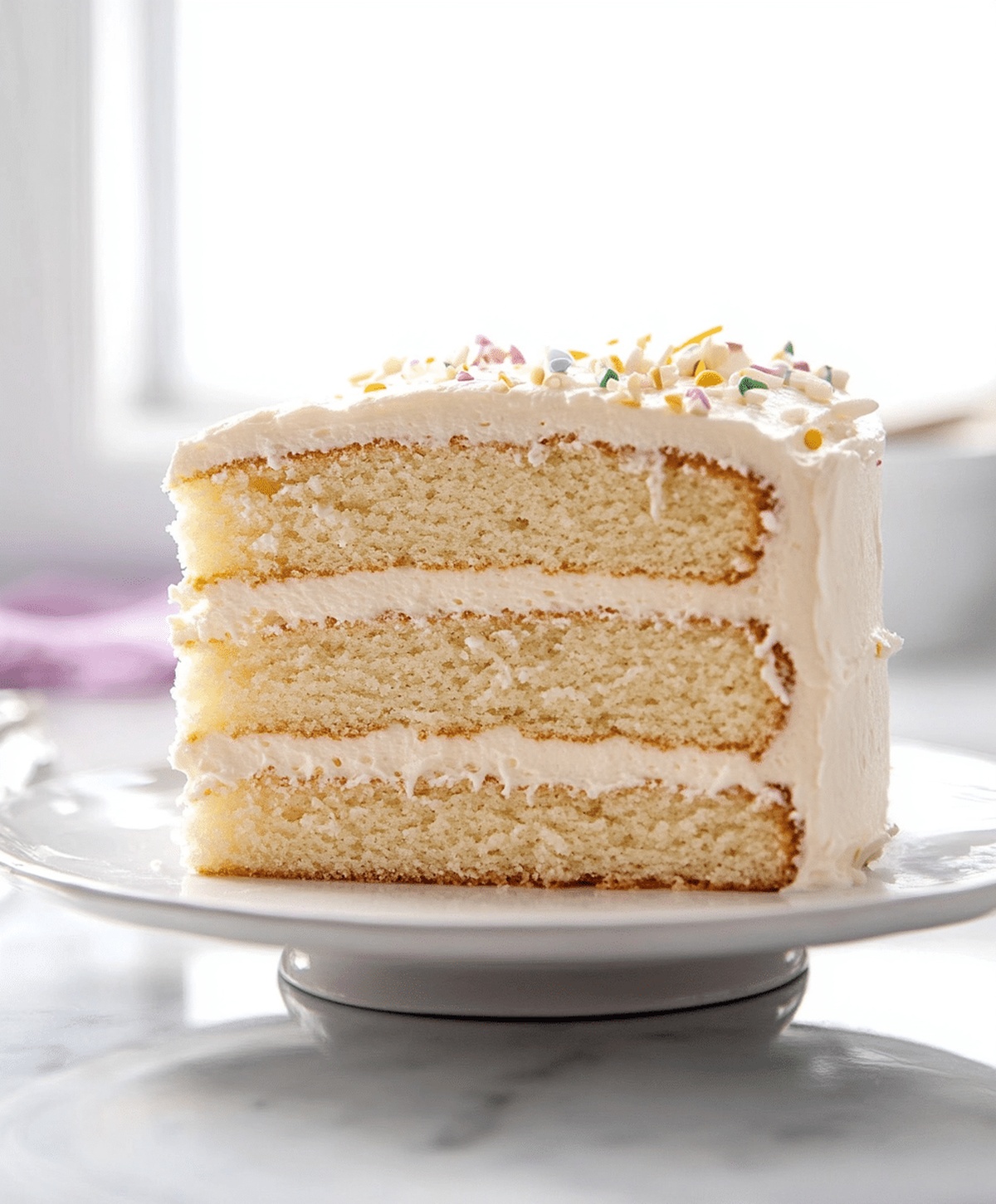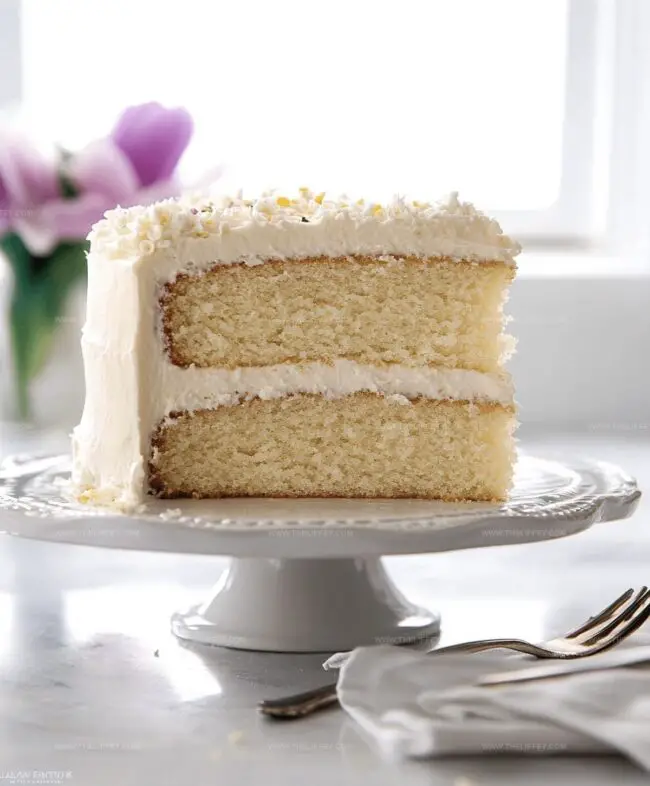Your Dreamy White Layer Cake Recipe: A Sweet Showstopper
Crafting a white layer cake brings pure joy to my kitchen adventures.
Soft, cloud-like textures promise delightful moments of sweetness.
Bakers seek perfection in every delicate crumb and smooth frosting layer.
Whispers of vanilla drift through the air, creating anticipation for something extraordinary.
My grandmother’s cherished techniques inspire each careful mixing step.
Precision matters when creating such a classic dessert.
You’ll fall in love with this foolproof recipe that guarantees smiles around the table.
Ingredients for White Layer Cake
Cake Base Ingredients:Wet Ingredients:Liquid Ingredient:Stepwise White Layer Cake Baking Guide
Step 1: Prepare Baking Equipment
Grab two 9-inch cake pans and generously coat them with butter and flour to prevent sticking. Set your oven to 350F (175C) and let it warm up while you prepare the cake batter.
Step 2: Mix Dry Ingredients
In a medium mixing bowl, combine:Whisk these ingredients together until they’re well blended and free of lumps.
Step 3: Cream Butter and Sugar
Using an electric mixer, beat butter and sugar in a large bowl until the mixture becomes light, fluffy, and pale in color.
This process helps create a soft, tender cake texture.
Step 4: Add Egg Whites
Gradually incorporate egg whites into the butter mixture, one at a time.
Beat thoroughly after each addition to ensure smooth integration. Stir in vanilla extract for a delightful aroma and flavor.
Step 5: Create Cake Batter
Alternate adding the dry flour mixture and milk to the butter mixture. Start and end with the flour mixture, gently folding to maintain the batter’s airiness.
Mix until just combined to avoid overmixing.
Step 6: Bake the Cake
Evenly divide the batter between the prepared cake pans.
Place in the preheated oven and bake for 25-30 minutes. The cake is done when a toothpick inserted in the center comes out clean.
Step 7: Cool and Prepare for Frosting
Allow cakes to rest in the pans for 10 minutes. Carefully transfer to wire cooling racks and let them cool completely before frosting or decorating.
Secrets to White Layer Cake Success
Creative Twists on White Layer Cake
Ways to Serve White Layer Cake
Best Storage for White Layer Cake
Methods for Reheating:FAQs
Cake flour has less protein, which creates a softer, more tender crumb with a finer texture compared to all-purpose flour, resulting in a lighter and more delicate cake.
Using only egg whites keeps the cake white and creates a lighter texture. Whole eggs will change the color and make the cake denser, potentially affecting the cake’s signature light and fluffy consistency.
Insert a toothpick into the center of the cake – if it comes out clean with no wet batter, the cake is done. The top should also be golden and spring back when lightly touched.
New Favorite White Layer Cake Story
Print
Best Favorite White Layer Cake Recipe
- Total Time: 50 minutes
- Yield: 12 1x
Description
Delectable white layer cake brings pure joy to dessert tables across America. Moist crumb and silky frosting create a classic celebration treat you’ll savor with pure delight.
Ingredients
Cake Base:
- 2 3/4 cups (345 grams) cake flour
- 1 tablespoon (15 grams) baking powder
- 1/2 teaspoon (3 grams) salt
Wet Ingredients:
- 1 cup (227 grams) unsalted butter, softened
- 1 3/4 cups (350 grams) sugar
- 4 large egg whites
- 1 cup (240 milliliters) whole milk
Flavor Enhancer:
- 1 1/2 teaspoons (7 milliliters) vanilla extract
Instructions
- Prepare baking equipment by coating two 9-inch round cake pans with butter and a light dusting of flour to prevent sticking.
- Combine dry ingredients in a mixing bowl, ensuring cake flour, baking powder, and salt are thoroughly blended with a whisk.
- Using an electric mixer, cream butter and sugar together until the mixture becomes light, airy, and significantly increased in volume.
- Incorporate egg whites individually into the butter mixture, mixing thoroughly after each addition to maintain a smooth, consistent texture.
- Gently fold in vanilla extract, stirring until evenly distributed throughout the batter.
- Gradually incorporate dry flour mixture and milk into the butter mixture, alternating between the two and ensuring smooth integration. Always begin and conclude with the flour mixture to maintain proper consistency.
- Evenly distribute the cake batter between the prepared pans, using a spatula to smooth the surfaces.
- Place pans in a preheated 350°F (175°C) oven and bake for 25-30 minutes, or until a toothpick inserted into the center emerges clean.
- Remove cakes from oven and allow them to rest in the pans for 10 minutes to stabilize their structure.
- Carefully transfer cakes to wire cooling racks and let them cool completely before frosting or decorating.
Notes
- Opt for room temperature ingredients to ensure smooth, even mixing and a lighter cake texture.
- Sift the cake flour twice for an ultra-fine, delicate crumb that melts in your mouth.
- Use a kitchen scale for precise measurements, especially when baking, to guarantee consistent results every time.
- Experiment with flavor variations by adding almond extract or lemon zest to complement the vanilla base.
- Prep Time: 20 minutes
- Cook Time: 30 minutes
- Category: Desserts
- Method: Baking
- Cuisine: American
Nutrition
- Serving Size: 12
- Calories: 274 kcal
- Sugar: 21 g
- Sodium: 144 mg
- Fat: 12 g
- Saturated Fat: 7 g
- Unsaturated Fat: 5 g
- Trans Fat: 0.3 g
- Carbohydrates: 36 g
- Fiber: 1 g
- Protein: 4 g
- Cholesterol: 25 mg



John Conley
Founder & Culinary Storyteller
Expertise
Recipe Development, Culinary Writing, Home Cooking Techniques, Seasonal Ingredient Utilization
Education
Lane Community College, Eugene, OR
Certificate in Culinary Arts
Focused on foundational cooking techniques, kitchen safety, and menu planning.
Gotham Writers Workshop, New York, NY
Course in Food Writing
Explored the art of crafting engaging culinary narratives and recipe development.
John grew up where food meant connection: big bowls, warm kitchens, and meals that told a story. After earning his Certificate in Culinary Arts from Lane Community College and diving deep into food writing at Gotham Writers Workshop, he found his calling: turning everyday recipes into something worth savoring.
At The Liffey, John’s focus is all about crafting dishes that feel easy, honest, and full of heart.